Brain
Without a human eye and brain there is no color.
Paul Doherty
Hilleary Osheroff
Teacher suggested materials
ipad app 3D4Medical Brain and nervous System $9.99 three dimensional visualization of the brain.
Electrical models of neurons from our friends at Backyard Brains https://backyardbrains.com/experiments/comparingNerveSpeed
Inexpensive unmarked Dominos are available for about $0.10 each from http://bulkdominoes.com
How can perception guide us toward understanding the brain.
Model of a nerve
Domino Model of a Nerve TI Workshop
Explore how a signal propagates only after exceeding a threshold, and how the speed of propagation and signal amplitude is independent of the trigger signal.
By tipping the ruler so the signal propagates uphill you can increase the tilt of the first domino required to trigger an action potential.
By tipping the ruler so the signal propagates downhill you can decrease the tilt of the first domino required to trigger an action potential.
Tipping the ruler thus models the inhibitory and excitatory signals received by neurons at their synapses.
Once a neuron fires it requires time, called the refractory period before it can fire again.
Here is drawing of two typical neurons. Almost touching at synapses.

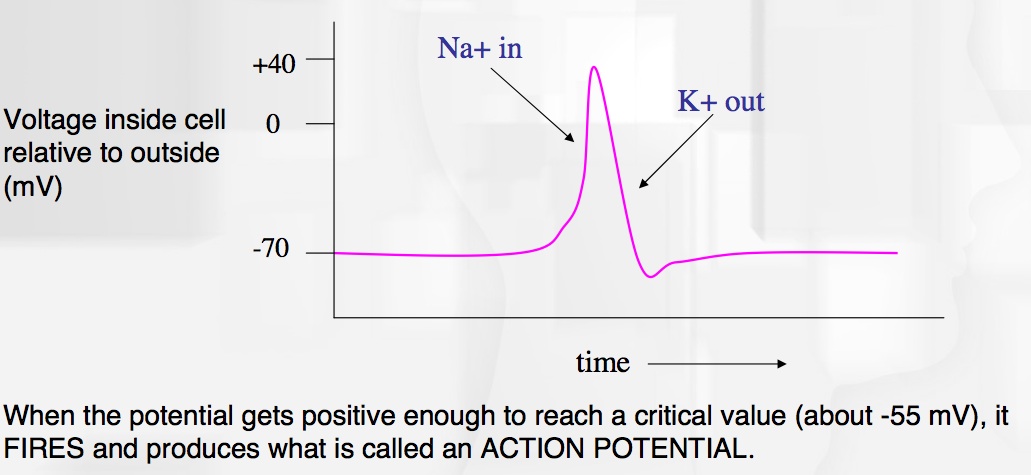
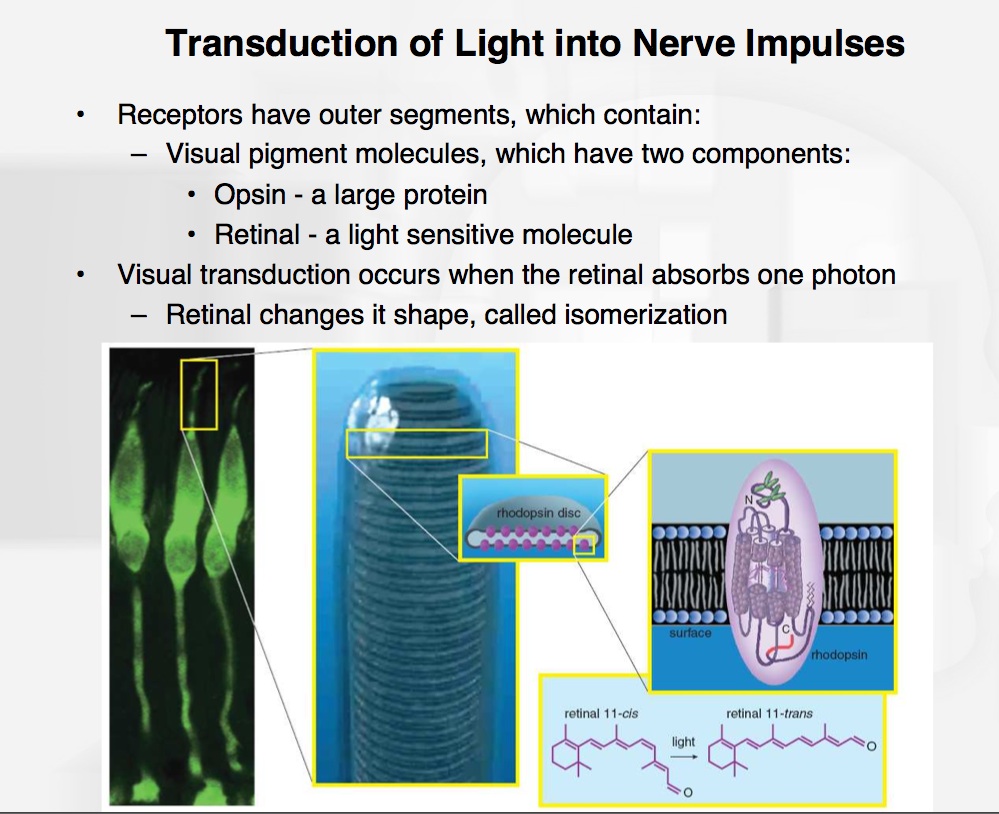
Other versions of this activity:
Domino Model of a Nerve, Human Body Book
Also found in the book, The Brain Explorer
Hilleary's Synapse exploration
Karen Klumuck's Smell and taste explorations as pdfs
Taste and Smell The Nose Knows
The Taste of Color
When Yellow is Yellower than Yellow
Stare for 30 seconds at the center of a bright yellow disk on a dark background, the left half of which is covered by white paper. Remove the paper and notice the yellow disk on the covered region glows more brightly than the uncovered half of the disk. Try covering it with other colored papers.
Brain Connection: Adaptation of brightness perception for color.
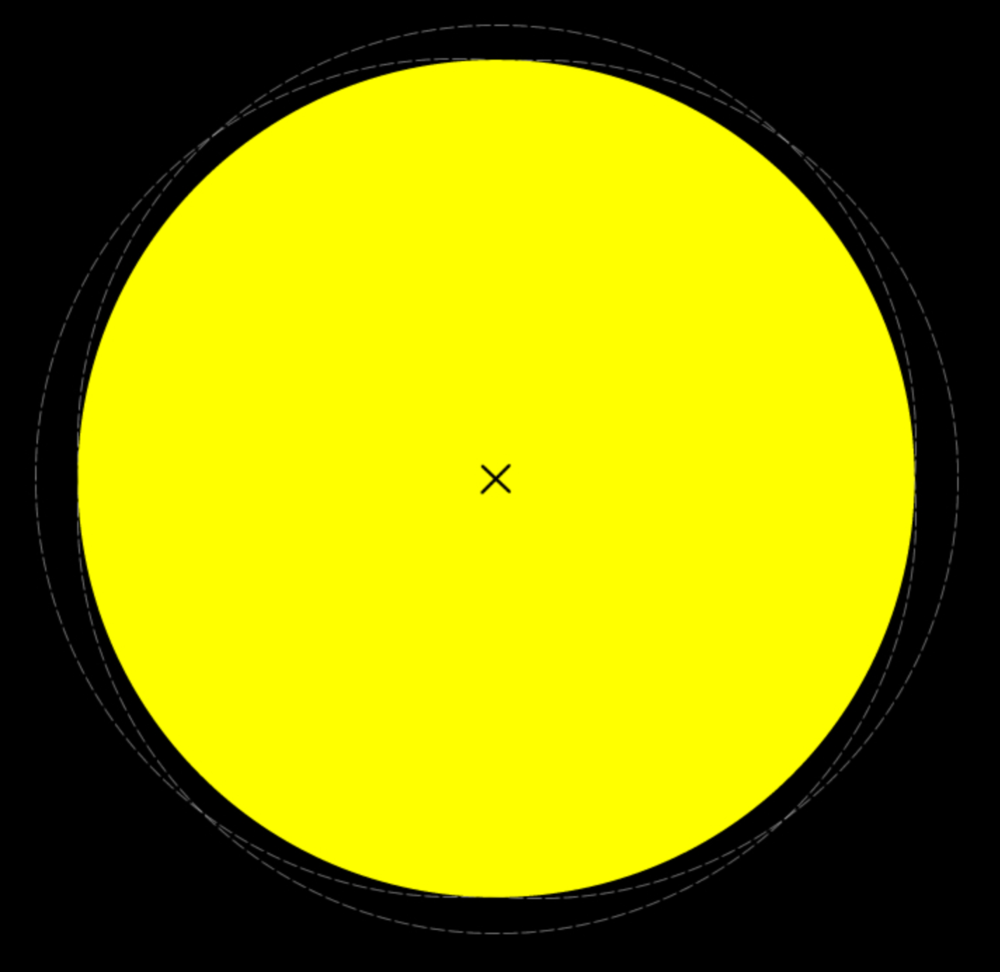
Cone cells in the retina, when they are exposed to intense light, adapt by decreasing their sensitivity. This means that cone cells exposed to bright yellow light decrease their sensitivity, so that when they observe yellow light they see it as dimmer than the same yellow seen by cone cells previously exposed to less intense yellow light. The adaptation of neuron firings based on previous firing rates is extremely important since it allows our perception to adjust to a wide range of conditions.
By the way yellow light is the perception of color created when both red and green sensitive cones fire. "Fire" a colloquial term describing when a neuron creates an action potential.
This illusion is available in the exploration "When Yellow is Yellower than Yellow" in the free ipad app Color Uncovered. Or just use this online yellow disk above.
A related exhibit is Fading Dot http://www.exploratorium.edu/exhibits/fading_dot/fading_dot.html in which the eye and brain adapt to a constant small gradient in color so that it vanishes from our perception.
Bird in the Cage
Stare at the center of the bird for 30 seconds. Then look in the cage. See a bird of a different color.
Brain Connection: Afterimage, neurons adapt to brightness by reducing the sensitivity of each color sensitive cone separately.
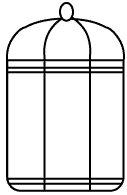
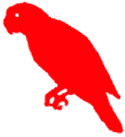
Bird In the Cage Online version
Bird In The Cage Snack version, how to build your own
When you look in the cage before staring at the bird it appears white. Red, green and blue cones in the retina are firing at rates which create a perception of white.
Stare at the eye of the red bird for 30 seconds then look in the cage. Notice the cyan bird.
The region of the retina upon which the red bird is imaged, has little green and little blue light, so the sensitivity of green and blue cones increases. The sensitivity of the brightly illuminated red cones decreases.
When you then look at a white surface inside the cage it then appears to have reduced red and increased green and blue, so you see a cyan bird.
Use the snack to see what would happen if you stare at a blue bird.
The bird appears even if after staring at the red bird you close your eyes and cover them so you see blackness. The glowing cyan bird still appears.
Another black and white version of Afterimage is available as a Snack http://www.exploratorium.edu/snacks/afterimage/index.html
For a more subtle version of this illusion see, "Colorize this photo with your eyes", in the free ipad app Color Uncovered.
Gray Step
Observe a gray rectangle with a cord in the middle, remove the cord and "see" two different gray areas. These two gray areas are identical.
Brain Connection: Neurons influence the sensitivity of adjacent neurons, aka lateral inhibition.
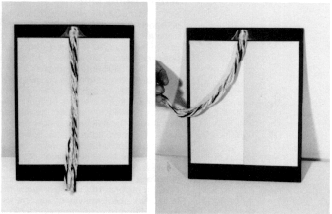
Gray Step This Snack includes download-able versions which can be printed on high quality printers.
Learn how the eye and brain emphasize change, for example edges.
There are 120 million rods and 6 million cone cells in each eye. There are1 million neurons in the optic nerve.
In simple terms before the image on a retina is sent to the visual cortex for processing it must be preprocessed by the retina.
Only 1% of the signal detected by the retina is passed to the visual cortex to construct a perception of the world.
Evolution has selected the 1% to maximize survival.
Gradual changes in intensity of light, are not sent along the optic nerve, however edges where brightness changes are sent.
The information obtained from the edge is then applied to the regions adjacent to the edge. Thus in the image above when the edge is blocked both regions look the same.
When the edge is revealed there are two regions each with a different shade of gray.
But this is still an illusion!
Each region is identical to the other. There is a gradual change in intensity of light scattered by the exhibit going from darkest on the left to brightest on the right.
Edges are emphasized because neurons influence adjacent neurons in the retina. A cone in bright light sends electrical pulses called the "activation potential" more often than one in dim light. Colloquially we say the neuron "fires." However, a cone in bright light that is firing more often turns down the sensitivity of an adjacent cone. If that adjacent cone is in dimmer light it will fire even less often due to the reduction in sensitivity created by its neighboring cone.
The reverse is also true. A slowly firing cone increases the sensitivity of adjacent cones. So the cone cell in dim light increases the sensitivity of adjacent cones. These cones then fire even more rapidly. Leading to a perception of enhanced brightness.
These effects are known as lateral inhibition and it enhances differences between adjacent neurons.
To a mathematician this coupling of adjacent cone cells is similar to taking a second derivative of intensity versus distance. Mathematical interpretation of gray step.
Hermann Grid
Dots appear in the intersections of this grid.
Brain Connection: Sensory neurons are grouped into center excitatory, surround inhibitory bundles on the retina,
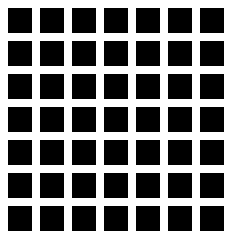
The explanation for the Hermann grid follows from the center-surround model of retinal sensors. Cones in the fovea are connected to neighboring cones. When enough light hits this cone it fires. When a cone in a circle of cones surrounding the center cone fires, it reduces the sensitivity of the center cone, it requires more light to fire. A cone in the middle of two intersecting light lines, like the one in the top left of the diagram below has its sensitivity reduced by the cones in the 4 light regions around it. A cone like the one on the bottom left ha only two light regions around it so its sensitivity is reduced by a lesser amount. Thus a dark smudge appears where the white lines cross.
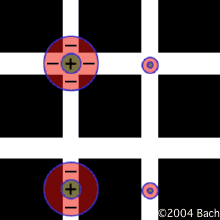
However, you may notice that when you actually look at a crossing point the dark smudge disappears. This is because only in the fovea are single cones connected. Outside the fovea rods and cones are connected in much larger bundles. This is illustrated by the center-surround regions shown on the right side. Where the small center-surround region of the fovea fits entirely withing the white lines of the array. So the size at which the Hermann Grid is printed matters.
Seeing Your Blind-spot
Cover your right eye with your right hand. Hold your left hand with its thumb up at arms length in front of your nose.
Move your thumb slowly to the left until it vanishes in your blind spot.
Brain Connection: The retina is backwards in some ways, the light passes through the blood supply and neurons before it is absorbed by the rods and cones.
When the neurons pass through the retina they create a place with no rods and cones, a blind spot.
Blind Spot Snack http://www.exploratorium.edu/snacks/seeing_blindspot/index.html
Shake My Colors
Look at three colored dots on a white screen: magenta yellow and cyan. Shake the screen side to side and notice the yellow dot lag behind the magenta and cyan dots.
Brain Connection: Some perceptions take longer to perceive than others.
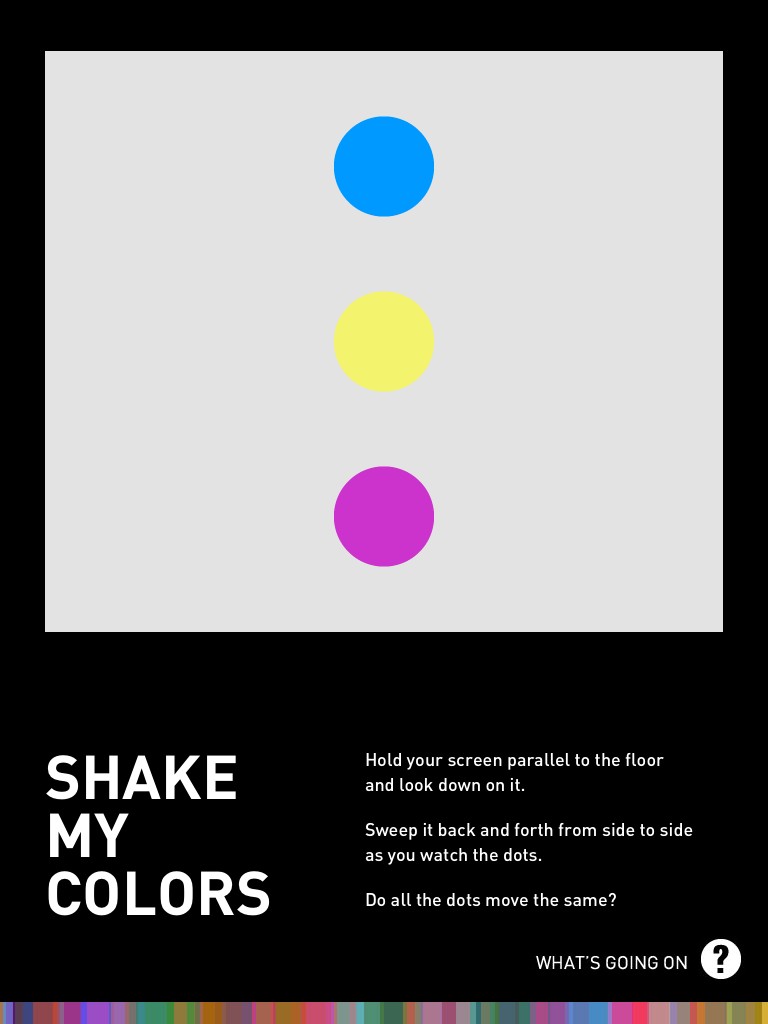
Shake the image right and left and notice that the yellow dot lags behind the magenta and cyan dots.
This illusion is available in the exploration "Shake My Colors" in the free ipad app Color Uncovered. Or just use this online image.
Notice that the yellow dot is closer in intensity to the white background than the darker magenta and cyan dots. It takes more time for the brain to perceive the subtle movement of color compared to the movement of different intensities. Thus the yellow dot which is said to be equiluminant when compared to the background, appears to lag behind the other dots.
See also the Pulfrich effect. which shows the time delay that occurs between stimulus and perception for a dim object versus a bright object.
Depth Spinner
A rotating disk creates a rotating spiral that seems to contract inward, this causes an aftereffect that makes things seem to expand when observed later.
Brain Connection: Very often neurons are connected in antithetical pairings, such as expanding and contracting, when one of these adapts and reduces its sensitivity, our perceptions are altered. When the disk is at rest, both the expanding sensitive neurons and the contracting sensitive neurons fire at about the same rate canceling each other out. After observing expansion for a while, the expansion sensitive neurons adapt and lose sensitivity, firing less. When a stationary pattern is observed the expansion sensitive neurons fire less and so the pattern is seen to contract.
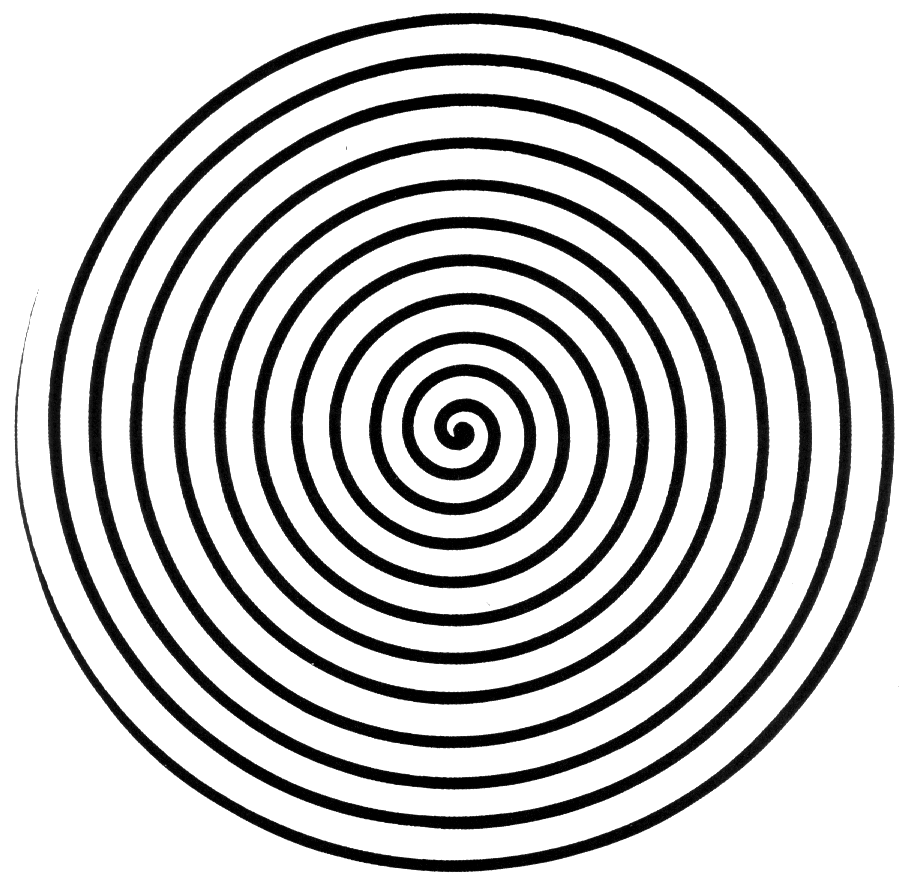
The Depth Spinner Snack and printable pattern http://www.exploratorium.edu/snacks/depth_spinner/depth_spinner_graph.html
Here is an online shockwave version from the Exploratorium http://www.exploratorium.edu/exhibits/depth_spinner/
There is a related illusion called the waterfall illusion. If you watch a waterfall for 30 seconds and then look to the rocks to one side of the waterfall the rocks seem to move upward. Once again in the visual cortex there are antagonist pairs of neurons that detect upward motion and downward motion. Watching downward motion for 30 seconds will cause the downward motion sensors to adapt and decrease their sensitivity. So that when stationary rock is observed the upward detecting neurons fire faster and you will perceive the rock flowing upward.
The Moon Illusion
The rising moon looks larger on the horizon than overhead.
Brain Connection: The brain uses multiple sensory inputs to decide the size of something. Perception of the distance to an object changes the perception of its size.

Measure the moon's angular size as it rises. The moon appears to be larger when it rises and is close to the horizon, and yet, measurement shows that it is the same size on th horizon as over head.
Brain Connection: The brain uses the perceived distance to an object to adjust our perception of the size of the object.
Related to the Moon Illusion is size constancy.

Perceived size depends upon more than the size of an image on the retina. The height of the image of a person on your retina is cut in half when the person doubles his or her distance from you. However they do not appear to shrink to a person that is half as tall. The brain adjusts its perception of height to allow for its perception of distance.
Peripheral Vision
Use your peripheral vision to perceive, motion, color and shape.
Brain Connection: You can map out the distribution and connectivity of rods and cones on the retina.
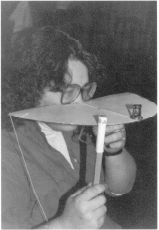
Peripheral Vision Snack http://www.exploratorium.edu/snacks/peripheral_vision/index.html
Persistence of Vision
By sweeping a slit across your field of view you can perceive the entire view.
Brain Connection: The brain can create a perception of an entire scene from a narrow slit swept across the scene.

Snack http://www.exploratorium.edu/snacks/persistence_of_vision/index.html
Pupil
Look at your pupil in a mirror as you shine a light into your eye, watch the pupil size change.
Brain Connection: The optic nerve splits and 10% of its neurons return to the eye to control the size of the pupils to adjust for light intensity.

Pupil Snack http://www.exploratorium.edu/snacks/pupil/index.html
You can even shine light into one eye and observe the pupil change size in the other eye, Some of the return neurons cross at the optic Chiasm and return to the opposite eye to control its pupil size.
Acoustic Illusion Find the Highest Note
Brain Connection: Other senses can be fooled by illusions.
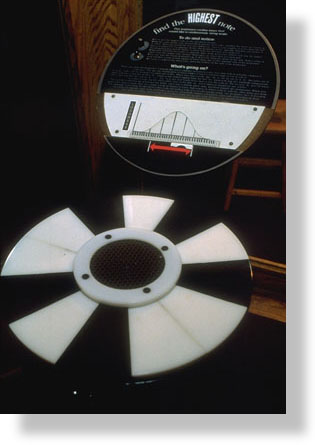
It note played clockwise around on this circular keyboard sounds higher than the previous note. Even when you play around to the original note.
Find the highest note Acoustic illusion. Museum exhibit available as an Ipad app. Sound Uncovered
Tactile Illusion
Brain Connection: Our perception of temperature is actually a perception of temperature change due to heat flow. It is common for perceptions to be based on changes rather than absolute values.

People line up by hand temperature. Then people from the ends of the line shake hands with everyone else.
When the hottest handed person shakes hands with the middle person the middle persons hands feel cold, when the coldest handed person shakes hands with the same middle person, the middle persons hands feel warm.
Verify the result with a thermal camera.
Resources
Exploratorium
website http://www.exploratorium.edu
Exhibits
Exhibit Services Catalog
http://exs.exploratorium.edu/exhibits/
Disagreeing about Color 20 people look at a circle of colors surrounding a central color and disagree on which color in the circle matches the one in the center. This is because their cones contain different mutations for the rhodopsin. This is known as color anomaly, and is a weak version of color blindness.
Disappearer, stare at the middle of a rotating wood grain disk , small objects suspended over the moving disk disappear because the brain emphasizes perception of motion.
How the brain organizes image perception (a video of the visitor is shown as colors, edges, moving edges and faces illustrating how the brain takes apart an image.)
Hoop nightmares http://exs.exploratorium.edu/exhibits/hoop-nightmares/ (Brain plasticity, wear goggles that deflect the visitors vision 30 degrees to one side and have them learn to shoot baskets.)
Snacks
The Exploratorium Science Snackbook http://www.exploratorium.edu/snacks/
Simple versions of Exploratorium exhibits which can be built for under $10
Benhams Disk how a black and white rotating pattern can produce the sensation of color http://www.exploratorium.edu/snacks/benhams_disk/index.html
Blind Spot http://www.exploratorium.edu/snacks/blind_spot/index.html
Cold Metal a touch illusion http://www.exploratorium.edu/snacks/cold_metal/index.html
Depth Spinner http://www.exploratorium.edu/snacks/cold_metal/index.html
Far Out Corners http://www.exploratorium.edu/snacks/far_out_corners/index.html
Gray Step http://www.exploratorium.edu/snacks/gray_step/index.html
Peripheral Vision http://www.exploratorium.edu/snacks/peripheral_vision/index.html
Seeing Your Retina http://www.exploratorium.edu/snacks/seeing_retina/index.html
Your Sense of Taste http://www.exploratorium.edu/snacks/your_sense_of_taste/index.html
Exploratorium Online interactive resources
Squirming Palm A rotating patterns causes aftereffects http://www.exploratorium.edu/exhibits/squirming_palm/index.html
Online interactive illusions http://www.exploratorium.edu/exhibits/changingill/
Cafe Wall Illusion http://www.exploratorium.edu/exhibits/cafe_wall/cafe.html
Sliding Gray Step http://www.exploratorium.edu/exhibits/gray_step/
Stroop Test (multilingual) colors versus color words http://www.exo.net/~pauld/activities/perception/stroopeffect/stroop.htm
McGurk Effect (also available as a snack version with 2 participants and a viewer.)
Apps
Sound Uncovered
Find the highest note, a sheppard tone series acoustic illusion.
McGurk Effect, sound versus sight
It Takes two, how two ears combine sounds.
Color Uncovered
Shake My Colors, equiluminant time delay.
See the Blue Square, It's not there
Fade to Green, unchanging blue smear disappears over time.
When is Yellow Yellower than Yellow, adaptation of sensory neurons
Colorize this photo with your eyes, a type of afterimage.
Exhibitions
Memory
Lectures on Memory
Sheep Brain Dissection
Cows Eye Dissection
Anatomy of a Memory 9 minute video of a human brain dissection
Webcasts
Compilation of webcasts on the brain
FMRI Look at a working brain
Diamagnetic grape http://www.exploratorium.edu/snacks/diamagnetism_www/index.html Use magnetic forces to probe the nature of materials
Paul Doherty website
http://www.exo.net/~pauld
Contains perception explorations in the first week of the following summer institute. Summer Institute also used at the science for monks workshop

Science for Monks
String Crossing
Seeing versus feeling. Look at one string. What do you see?
Second Life
Exploratorium, Splo sims
3D interactive virtual world , exhibits and exhibit prototyping.
Twinkle Suppressor
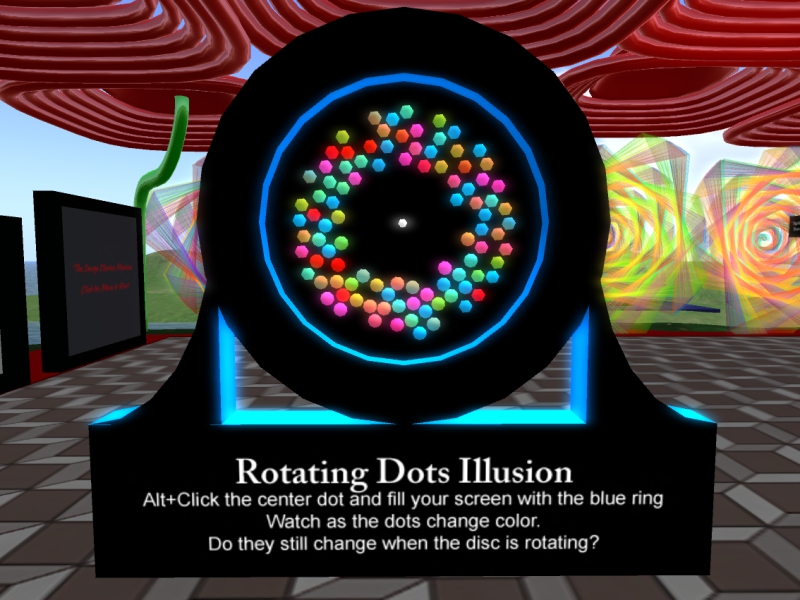
When twinkling dots rotate the perception of twinkling is reduced.
Publications
Exploratorium Science Snackbook
print and online
Gray Step
Human Body Explorations
online
and in print as a book
Human Resources
Exploratorium Scientist Luigi Anzivino PhD Neurophysiology
Internal Resources
Cumulus Database (A database of exploratorium digital assets accessible to staff only)
http://archive.exploratorium.edu:8080/exploratorium/ guest access username teacher password institute
On this database you can find the 90 minute video, Human Brain Dissection, by Marion Diamond .
External Resources
Project LITE: Prof Kenneth Brecher
Eye and Brain: Richard Gregory
Seeing the Light: Falk, Brill,Stork
Eric Chudler Neuroscience for kids
Neurons and perception http://courses.washington.edu/psy333/lecture_pdfs an excellent collection of illustrations
These first resources are from Tammy
Scroll down to find Paul's resource lists.
Perception and the Brain Resource List
Altered Reality Activity
There are several write-ups out there for the altered reality goggle activity, including the Exploratorium’s “Hoop Nightmares.” This particular guide from the University of Minnesota’s BrainU focuses on neural plasticity as the central theme. The site includes teacher and student guides, notes for the teacher, and possible extensions. And check out the rest of their site for some great inquiry-based neuroscience activities for middle and high school.
http://brainu.org/altered-reality
Making the Goggles
In today’s activity, we used 3M press-on Fresnel lenses with a 30 degree diopter. The price of these have increased significantly over the past few years. (Are you sitting? $19 per lens. That means $38 per pair!) Not doable for most. You might consider pooling resources to make a set and share them. You will need to order by phone. Information can be found here:
http://www.fresnel-prism.com/products/-3m-press-on-optics/
OR
Use plastic prisms. RAFT usually has them pretty cheap. Check out the Exploratorium’s “Hoop Nightmares” exhibit on the floor, or the snack version for instructions on how to make the goggles using prisms.
OR
You can use magnifying sheets that are sold at stationary stores and do some creative cutting (see description in the handout linked above). Because these are curves, the effect is a bit off, but they work fairly well. Make sure that you purchase the thin plastic sheets rather than the thick ones so that they can be cut.
Card Sort Activity
This activity explores the relationship between motor response time and cognitive load using a deck of playing cards. It offers opportunity to explore data analysis and critique experimental design. The site includes teacher and student guides, teacher notes, and guiding questions for students.
http://brainu.org/card-sort-challenge
Project Implicit
This research applies the ideas relating cognitive load and motor response time we explored in the card sort activity to take a closer look at our implicit associations about race, gender, sexual orientation, and other topics. This activity requires sensitivity and significant maturity from the students.
At this page, you are able to select featured tasks OR a random social task will be selected for you.
https://implicit.harvard.edu/implicit/
If you would rather select which task you are assigned, try this link instead:
https://implicit.harvard.edu/implicit/selectatest.html
You can find an explanation of the test design and results here:
https://implicit.harvard.edu/implicit/demo/background/faqs.html#faq7
Learning and the Brain
This page developed by the Association for Supervision and Curriculum Design (ASDC) has some great information on learning backed up with neuroscience.
http://www.ascd.org/publications/books/107006/chapters/Memory,_Learning,_and_Test-Taking_Success.aspx
Brain Zoo
In this activity, students observe external brain anatomy to identify the needs of various animals and identify the types of brains. Intended for grades 9-12, but can be adapted for middle school.
http://brainu.org/brain-zoo
Animations
These quick animations on the BrainU site give clear explanations of complexities of the neurons. Titles include Action Potential, The Synapse, Synapses Change (associated with learning), and Toxins and Synapses.
http://brainu.org/movies
Senses and Sensitivity - Neural Processing: Making Sense of Sensory Information
Part of the Howard Hughes Medical Institute’s (HHMI) Holiday Lecture Series, Dr. Jeremy Nathan explains more about how we process auditory and visual cues. (Intended for teachers – may be a bit slow for students).
http://media.hhmi.org/hl/97Lect4.html
